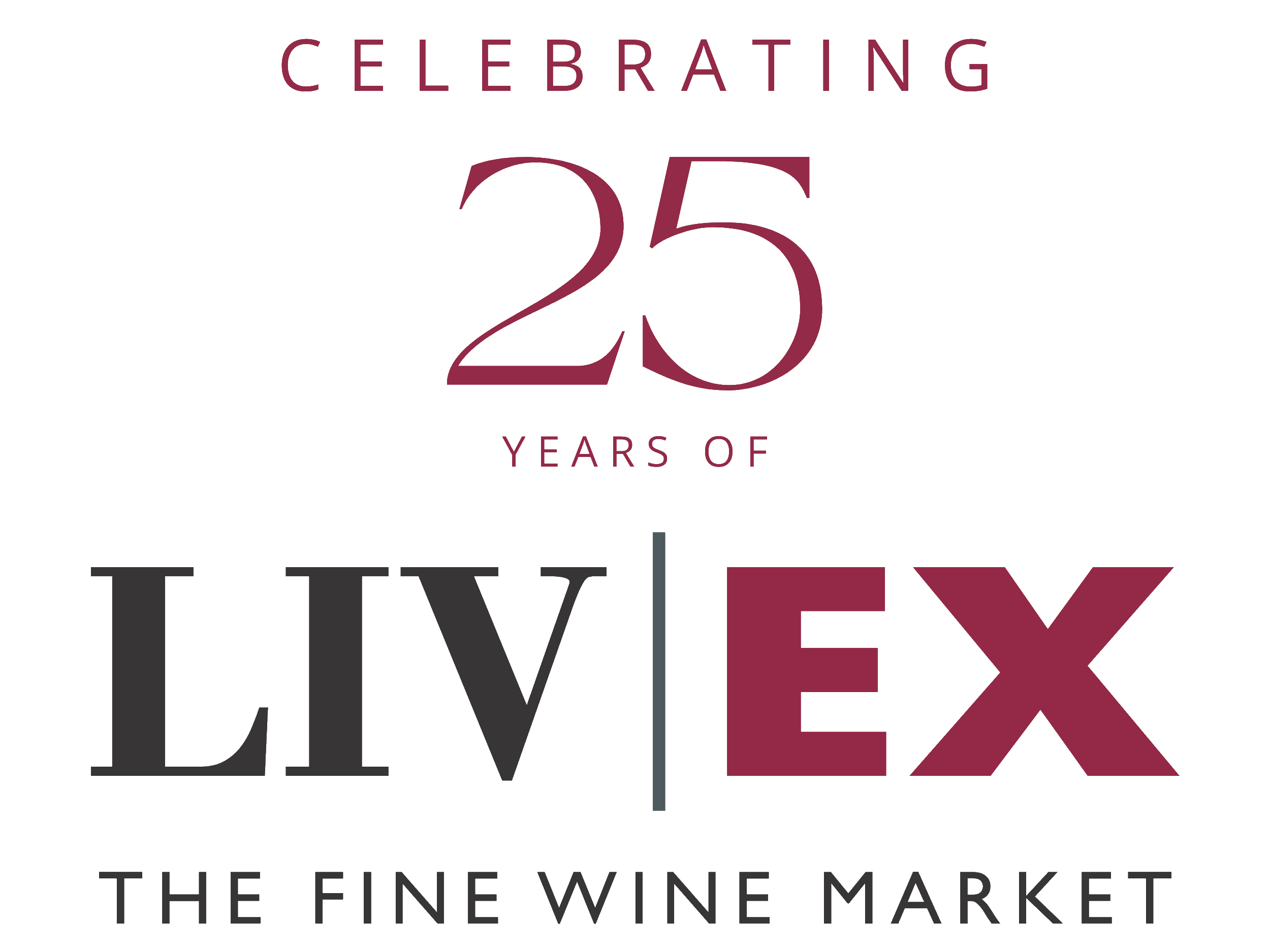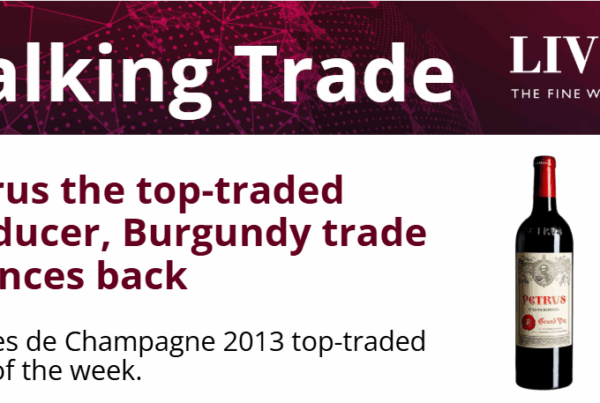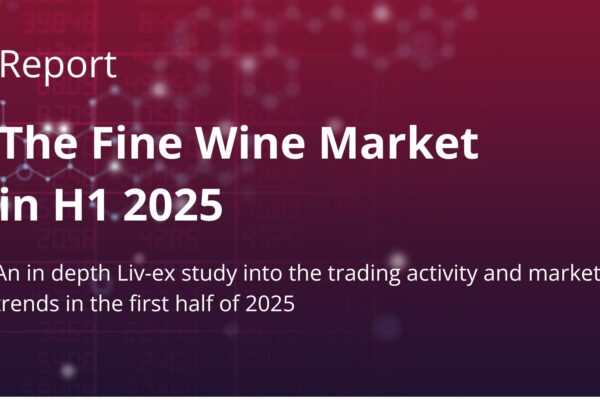Print and read offline instead.
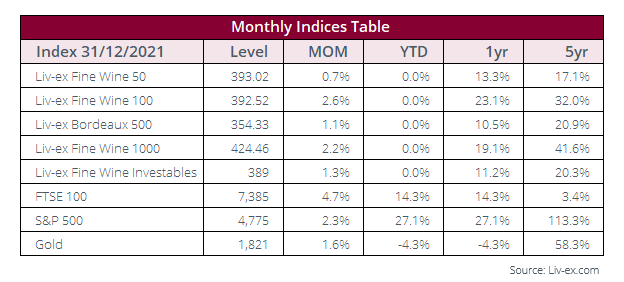
The fine wine market ends 2021 at a record high
The Liv-ex Fine Wine 100 index rose 23.1% in 2021, outperforming gold and the FTSE 100. The industry benchmark has been trending upwards since May 2020, with the fine wine market continuously breaking records – including an all-time high exposure.
The Liv-ex Fine Wine 1000 index went up 19.1%. While all of its sub-indices made gains last year, the Champagne 50 stood out, with a 40.5% annual rise. The Burgundy 150 was the next-best performer, up 31.0%.
In terms of December trade share, Burgundy (29.8%) overtook Bordeaux (25.4%) to become the most traded region by value. Champagne took 13.0% of the market, while the Rhône and the USA accounted for 4.2% and 7.6% respectively.
The most traded wine by value in December was Domaine de la Romanée-Conti La Tâche 2018, with Château Cos d’Estournel Pagodes de Cos 2016 being the most traded by volume.
Sassicaia 2018 leads trade by volume in 2021
Sassicaia 2018 was the most traded wine by volume in 2021. The wine broke a couple of trading records in the last week of the year; including a magnum that traded on New Year’s Eve for £644 (1×150), setting an all-time high.
The wine has enjoyed ongoing flurry of activity in the new year too. It last traded for £2,300 per 12×75, up 9.2% on its current Market Price (£2,106).
Sassicaia 2018 trades on Liv-ex
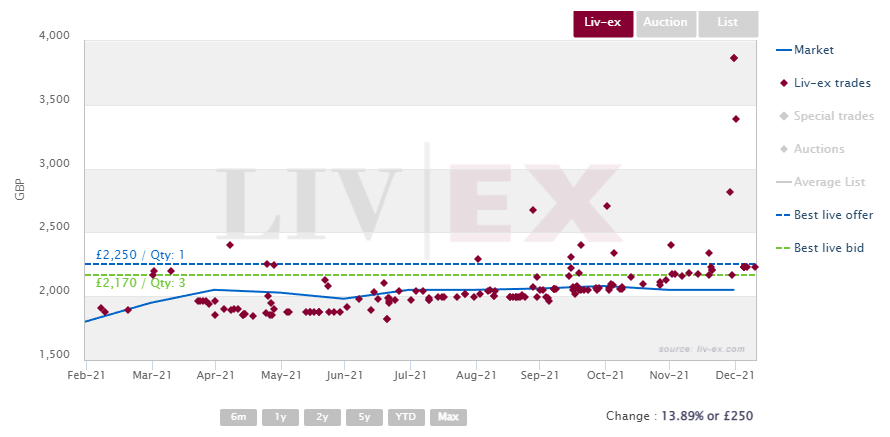
While the 2018 has been met with the most demand, other Sassicaia vintages enjoyed bigger price rises last year. For example, the 2010 rose 34.3%, followed by the 2015 (29.8%) and 2009 (24.1%).
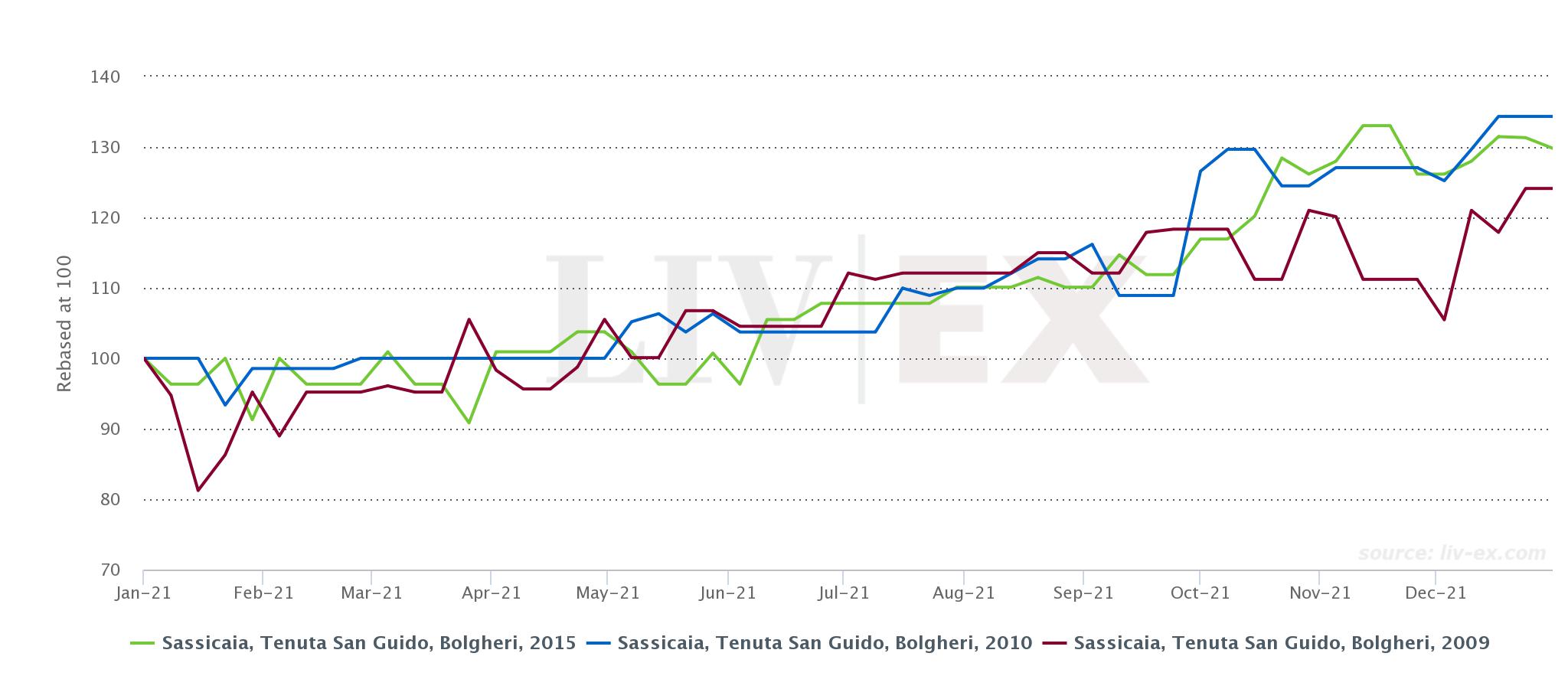
*made with the Liv-ex Charting tool.
Jancis Robinson publishes Burgundy 2020 scores
Ahead of the Burgundy 2020 campaign, JancisRobinson.com has published 92 scores of the new vintage. The wines were reviewed by Andy Howard MW, Julia Harding MW and Jancis Robinson MW at a London tasting, and covered cuvées from the négociants Domaine Bichot, Domaine Chanson, Domaine Faiveley and Domaine Jadot.
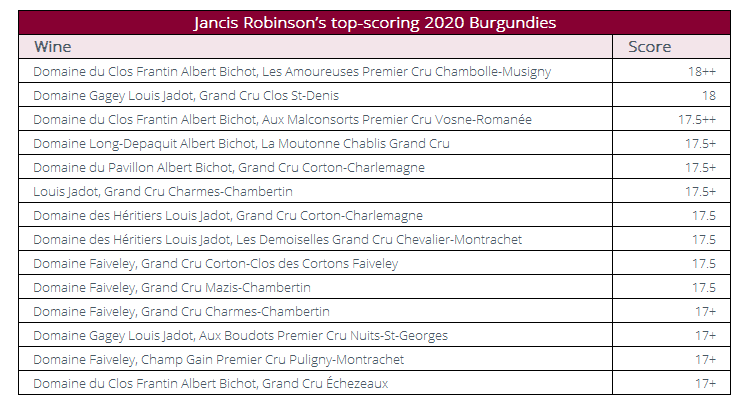
Regarding Bichot, Howard said that ‘this tasting was an ideal opportunity to see how Bichot has performed in this exciting (for wine quality) year’. A wine from Bichot also received the highest score, with Domaine du Clos Frantin Albert Bichot Les Amoureuses Premier Cru Chambolle-Musigny scoring 18++ points. According to Howard, the wine ‘more than delivers what is expected for a premier cru’.
Meanwhile, Robinson reviewed the wines of Chanson. She found the wines to be ‘quite varied stylistically’, but noted that the grapes had been grown by many different vignerons with ‘possibly different philosophies’. She observed that some of the reds ‘seemed extraordinarily sweet and ripe […] whereas others such as the Savigny Dominode were exceptionally fresh’. Robinson awarded five wines 17-points – her highest score at the tasting.
Finally, Harding scored the wines of Faiveley and Jadot. On Faiveley, she wrote that ‘the Mazis-Chambertin stood out for its elegance’ and ‘the Clos des Cortons for its generosity’. Harding praised the ‘refinement of the red [Jadot] wines, even at this point in their evolution’. Her top score went to Domaine Gagey Louis Jadot Grand Cru Clos St-Denis (18), which she described as ‘complete, harmonious, exciting wine’.
The best Liv-ex 100 price performers in December came from Burgundy

*Data taken from Indices Explorer.
Burgundy was in the spotlight this December, as demand for the region’s top wines continued to outstrip supply. A number of wines Burgundians went up in value between 10% and 33%.
Domaine Leflaive Puligny-Montrachet Premier Cru Clavoillon 2015 was the biggest mover last month, up 33.3%. The wine has a current Market Price of £2,000 per case.
Another more expensive Burgundian from the same vintage, Domaine Leroy Vosne-Romanée Premier Cru Les Beaux Monts 2015, took the second spot, rising 21.3% last month.
The 2015 vintage stood out, with three of top five price performers stemming from it.
Stay tuned, our annual Burgundy report will be published exclusively for Liv-ex members later this month. The report will examine the state of the Burgundy’s secondary market in the context of this year’s campaign.
Château Angélus quits St Emilion classification
Château Angélus surprised many in the new year when it announced it would not participate in the up-coming St-Emilion classification. The estate issued a statement saying that the ‘classification has become a vehicle for antagonism and instability’. Owner Hubert de Boüard was fined last year as a result of the long-running legal dispute that marred the 2012 classification. Two other grand cru classé ‘A’ estates, Ausone and Cheval Blanc, also withdrew from the process last year.
Claude Taittinger dies
Claude Taittinger, the former managing director of Champagne Taittinger, has died aged 94. He joined the family business in 1949 and became managing director in 1960. He retired in 2006 when the family group Société du Louvre (which included Concorde Hotels and Baccarat Crystal) was broken up.
Margareth Henríquez to leave Krug
Champagne Krug’s CEO, Margareth Henríquez, is leaving the house after 12 years. She will join crystalware producer Baccarat in the spring. Her replacement at Krug will be Manuel Reman, the current president of Moët Hennessy Champagne Services.
Changes and updates to the Liv-ex 100 and Liv-ex 1000
Both the Liv-ex 100 and Liv-ex 1000 will feature new wines from the end of January 2022. This is part of an annual revision that ensures that the index accurately reflects the market. Older and low liquidity wines are pushed out to make room for more active wines. To qualify, wines must have critical acclaim, be physically available on the market (wines trading En Primeur are excluded) and attract regular demand. Find out what is changing and why here.
Secondary market hits £100m exposure
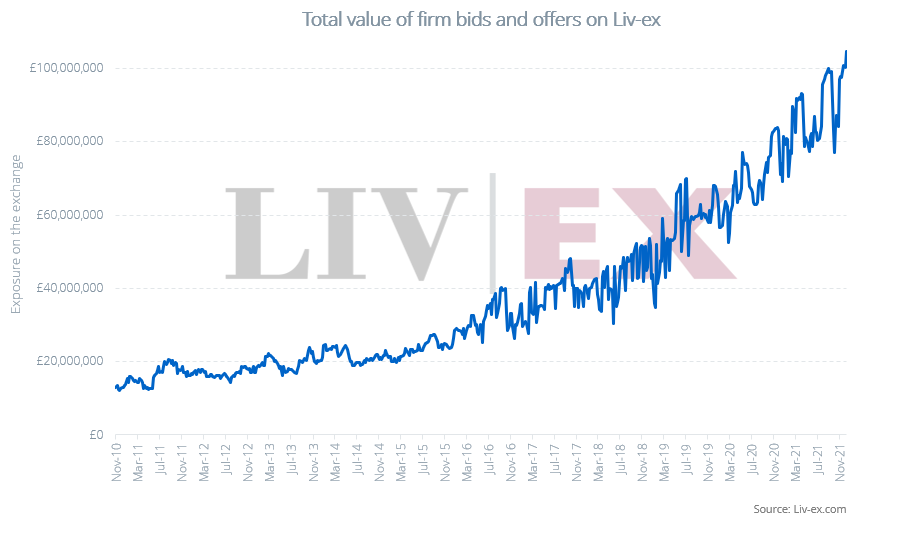
The new year began with the news that the total value of bids and offers on Liv-ex had surpassed £100 million.
This milestone capped what had been an extraordinary year of growth for the secondary market, as detailed in our end of year report. Historically, a bid to offer ratio of 0.5 is a clear indication of positive market sentiment. The current ratio is 1:7.
In 2021 the market continued to broaden and diversify. Every record regarding total value and volume of wines sold, as well as the variety and number of wines sold, was broken over the last 12 months.
The fine wine market’s benchmark index, the Liv-ex Fine Wine 100, rose 23.1% in 2021 and surpassed its previous record high set back in 2011. In doing so it out-performed several traditional equity markets such as the FTSE 100 and Dow Jones, as well as commodities like gold.
The much broader Liv-ex Fine Wine 1000 rose 19.1% and likewise finished the year at a new peak.
The broadening market
A vital part of the market’s success in 2021 was the greater variety of wines in demand. In total, 4,582 wines (as measured by LWIN7s) were traded last year, 11.8% higher than the 4,096 traded in 2020. Looking at the number of wines traded when identifying each wine by vintage (LWIN11), that number rises to 12,069, 16.5% more than in 2020.
This continued diversification of the market meant more wines were trading for the first time. For example, the first ever secondary market trades for wines from Armenia and the Crimea happened last year.
There was also activity for wines from French, Italian and Portuguese regions that hadn’t traded before; Savoie, Lugana and Tejo. Last year, wines from a record 20 countries and 86 regions traded overall.
There was also a broadening within established regions. This was most pronounced was Burgundy which saw the biggest increase in wines trading year-to-date, as well as being the region with the highest number of wines trading.
Burgundy exemplifies the case of diversification within the region itself, as buyers seek value among different price tiers which enables new domains to enter the secondary market.
Champagne leads price performance
Although Burgundy had a strong year – taking its highest ever share of total trade by value (22%) – the standout performer was Champagne.
The Champagne 50 – a sub-index of the Liv-ex 1000 – rose 40.5% between January and December 2021. Only one of its constituent wines retuned a negative performance, and Salon 2002 was the best-performing wine, rising 108% by the end of December to £12,300 (12×75).
The performance of the Champagne 50 only seemed to get stronger as the year came to an end. The index rose 8.1% in November and 5.8% in December, putting on the afterburners to leave its fellow sub-indices far behind. Only the Burgundy 150 which rose 31.0% ended the year with anything close to the same record.
The year was also marked by rising demand for rosé Champagne. In particular, sales in the US grew and were up 219% compared to 2020.
As the new year begins, the secondary fine wine market is not only broader and deeper than ever but offers a wealth of buying and selling opportunities too.
Liv-ex analysis is drawn from the world’s most comprehensive database of fine wine prices. The data reflects the real time activity of Liv-ex’s 560+ merchant members from across the globe. Together they represent the largest pool of liquidity in the world – currently £100m of bids and offers across 16,000 wines. Independent data, direct from the market.
